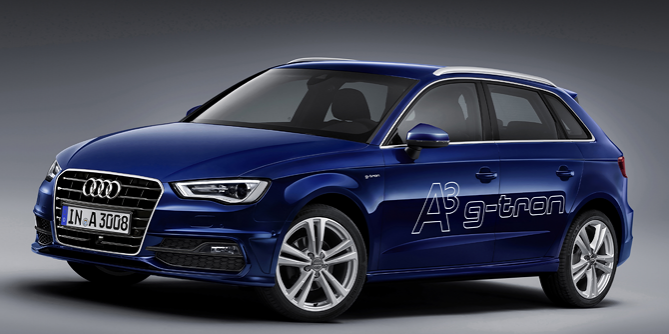
Audi Hybrid Technology – Audi A3 Sportback g-tron hybrid
Published by Autobahn Buzz (Audi Hybrid)
Audi is actually taking a substantial step towards lasting flexibility involving the A3 Sportback g-tron hybrid. The compact five-door vehicle, due to create its launching at the end of the year, is powered through the CO2-neutral fuel Audi e-gas.
The Audi A3 Sportback g-tron hybrid arrives with the total range of Audi’s innovation expertise– from ultra-lightweight technology, and also infotainment, to driver assistance systems. First and also foremost it showcases state-of-the-art CNG drive technology, beginning using the fuel storage.
The containers include a fresh kind of matrix. The inner layer comprises of gas-impermeable polyamide polymer (GIPP), while a second level of carbon fiber-reinforced polymer (CFRP) provides the tank its extremely high durability; a 3rd level of eyeglasses fiber reinforced polymer (GFRP) gives ruggedized security from harm through the exterior. High-strength epoxy plastic resin is utilized to bind the fiber reinforced materials.
A next highlight of the Audi A3 Sportback g-tron hybrid is its electronic gas pressure regulator. This compact because light component reduces the high pressure of the gas flowing through the cyndrical tubes to around 5 to 9 bar in two phases.
It assures that the appropriate pressure is actually always current in the gas rail and at the injector valves– reasonable tension for effective driving in the lesser velocity range, and higher when the driver requires more power and also torque.
The engine administration system immediately changes over to gasoline operation if the tension in the storage tank drops underneath ten bar. The Audi A3 Sportback g-tron hybrid is thoroughly bivalent, i.e. its functionality figures equal in CNG and gas forms.
CNG gives a range– based upon standard fuel consumption– of around 400 kilometres (248.55 miles), with fuel supplying one more 900 km (559.23 kilometers) if necessary; the absolute range is actually roughly on a par involving an Audi TDI. A couple of showcases in the instrument cluster provide the vehicle driver with current info on the fuel level in each of the tanks. The motorist details system also presents the present fuel consumption based upon the operating mode.
The 2 filler necks are set under a popular fuel flap. After refueling, and whenever it is actually extremely frigid, the engine is started involving gasoline initially, at that point it is converted to natural gas as promptly as achievable.
Developing 81 kW (110 hp) and 200 Nm of torque, the Audi A3 Sportback g-tron hybrid maintains a top speed of 190 km/h (118.06 mph), involving 0 to 100 km/h (0 – 62.14 miles per hour) having eleven moments. The five-door auto consumes on average less than 3.5 kilos per 100 kilometres of CNG or even Audi e-gas– the fuel that is actually produced from eco-electricity in the Audi e-gas project.
The greenhouse gas balance ares much more eye-catching in a well-to-wheel analysis that explains all factors through the fuel source to the car’s wheels. When the A3 Sportback g-tron hybrid is actually powered by Audi e-gas, say goodbye CO2 is launched than was chemically input in its manufacturing beforehand– producing a closed loop. When the electricity required to develop the e-gas establishment and also wind power generators is actually incorporated in an extensive investigation, CO2 emissions are still below 30 grams each kilometres (48.28 g/mile).
Investors of the Audi A3 Sportback g-tron hybrid are going to supposedly acquire the e-gas at everyone CNG refueling stations by means of an environmental accounting strategy, just like the technique presently in presence for getting eco-electricity.
With the e-gas job, Audi is the initial vehicle producer to create an entire chain of sustainable energy carriers. The start of the chain has electricity generated from renewable energy resources; completion items are hydrogen and also the synthetic Audi e-gas. Development of the globe’s first industrial factory to produce synthetic methane (e-gas) through CO2 because renewable electricity is actually practically finished in Werlte (Emsland area of Lower Saxony), Germany.
The Audi e-gas plant makes use of the renewable electricity in the 1st stage for electrolysis– splitting water into oxygen as well as hydrogen (Audi e-hydrogen), which can someday power fuel-cell cars. Because there is not however an extensive hydrogen infrastructure, having said that, the hydrogen is than reacted using CO2 in a methanation flower to make renewable synthetic methane, or Audi e-gas. Chemically talking, this e-gas is actually similar to fossil-based natural gas. Therefore, this can easily be delivered to CNG terminals through the natural-gas network.
Many thanks to the power-to-gas procedure, the electricity grid and gas network are actually being linked bidirectionally for the first time. Yet while you might produce electricity through gas, the back was actually not possible. The Audi e-gas plant subsequently ushers for delving into the natural-gas network using its enormous capacity as a storage and transport unit for hitherto excess electricity capacity.
The CO2 used in Audi’s e-gas plant is a waste item from a close-by biogas plant, run by power utility EWE. The CO2, which would typically pollute the setting, is actually chemically bonded into the fuel at the Audi e-gas plant. The e-gas plant will every year create about 1,000 metric bunches of e-gas because are going to chemically bind some 2,800 statistics bunches of CO2. This corresponds approximately to the amount of CO2 that 224,000 beech trees soak up in a year.
The CO2-neutral e-gas from Werlte perseverance 1,500 brand-new Audi A3 Sportback g-tron hybrid autos 15,000 kilometers (9,320.57 distances) each year. The power field can easily likewise gain because of Audi’s e-gas venture, as this takes care of the piercing difficulty of the best ways to stash sizable quantities of renewable electricity generated from wind turbines because photovoltaic systems effectively because irrespective of place. The electricity-gas cogeneration technology can dramatically stimulate the growth of renewable resources.
The Audi A3 Sportback g-tron hybrid arrives involving the complete gamut of Audi’s technology knowledge– from ultra-lightweight technology, and infotainment, to driver assistance systems. The five-door automobile consumes on common much less compared to 3.5 kilograms per 100 km of CNG or Audi e-gas– the fuel that is actually produced through eco-electricity in the Audi e-gas project. When the A3 Sportback g-tron hybrid is powered by Audi e-gas, no more CO2 is launched compared to was actually chemically input in its production ahead of time– producing a closed loop. The Audi e-gas plant utilizes the renewable electricity in the initial period for electrolysis– splitting water into oxygen because hydrogen (Audi e-hydrogen), which could one day power fuel-cell cars. The CO2-neutral e-gas from Werlte will power 1,500 brand-new Audi A3 Sportback g-tron hybrid vehicles 15,000 kilometers (9,320.57 miles) every year.




